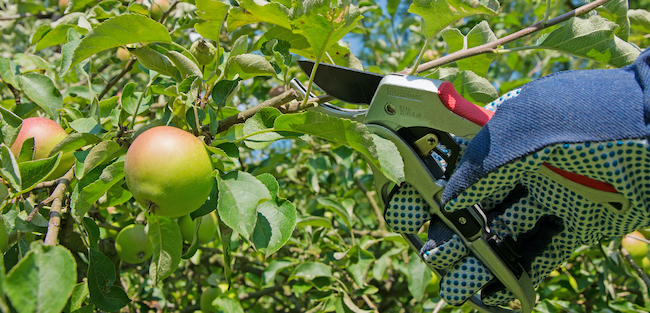
Pruning is an essential practice in fruit tree cultivation that plays a crucial role in maximizing productivity and maintaining the health and vitality of the trees. By understanding the art of pruning and proper branch training, fruit tree growers can unlock the full potential of their trees and enjoy abundant harvests year after year. In this article, we delve into the importance of pruning in fruit tree productivity, after previously consulting with fruit trees for sale experts at ChrisBowers, exploring the techniques and strategies that can help optimize branch development and fruit production.
The Benefits of Pruning
Pruning serves multiple purposes in fruit tree cultivation. Firstly, it helps to shape the tree’s structure, ensuring an open and well-ventilated canopy. This allows for better sunlight penetration, which is essential for photosynthesis, the process by which plants convert sunlight into sugars necessary for fruit development. Adequate sunlight exposure promotes healthy leaf growth, flower formation, and fruit ripening.
Furthermore, pruning encourages the growth of new, healthy shoots and branches. By removing old, unproductive wood, the tree directs its energy towards the development of new growth, which is more vigorous and productive. Pruning also helps to manage the size and shape of the tree, making it more manageable for maintenance tasks such as harvesting, pest control, and disease management.
Training Fruit Tree Branches
One of the key aspects of pruning is training the branches of fruit trees to grow in specific shapes and forms. This practice, known as branch training or espalier, allows for efficient use of space, increased sunlight exposure, and easier management. Different training techniques offer various advantages depending on the available space, desired tree size, and aesthetic preferences.
The central leader form is commonly used for larger, freestanding trees. In this form, a single dominant vertical branch is maintained, with side branches growing outwards. This shape provides good structural support and balanced distribution of branches.
The open center form, also known as the vase or goblet shape, is suitable for smaller or semi-dwarf trees. It involves pruning the central leader and allowing several main branches to develop, creating an open, bowl-like structure. This shape allows for excellent light penetration into the canopy and encourages good airflow, reducing the risk of fungal diseases.
Espalier training is a technique that involves training branches along a support structure, such as a trellis or fence, to create a two-dimensional, space-saving tree form. Espaliered trees not only maximize fruit production in limited space but also create a visually striking display in the garden.
Pruning Techniques
Timing and technique are crucial in pruning fruit trees. The dormant season, typically in late winter or early spring before new growth begins, is the best time for major pruning. During this period, the tree is less susceptible to stress and diseases, allowing for optimal healing and regrowth. However, minor pruning, such as the removal of dead or diseased branches, can be done at any time.
When pruning, it is important to identify and remove any dead, damaged, or crossing branches. These branches can impede airflow, create rubbing and wounds, and become entry points for pests and diseases. Thinning out excess branches also ensures that the remaining ones receive adequate sunlight, nutrients, and water, promoting the development of healthy and productive shoots.
Pruning cuts should be made just above the branch collar, which is the swollen area where the branch connects to the trunk or larger branch. Making the cut at the proper location allows the tree to heal more effectively and reduces the risk of infection.
Rejuvenation Pruning
Rejuvenation pruning is a technique used to revitalize older fruit trees that have become less productive. As trees age, their productivity may decline due to factors such as disease, reduced vigor, or lack of proper pruning. Rejuvenation pruning involves selectively removing older branches and encouraging the growth of new, vigorous shoots.
To rejuvenate an older fruit tree, start by removing any dead, diseased, or damaged wood. Next, thin out overcrowded branches, retaining those that are well-positioned and have good vigor. Finally, prune back some of the remaining branches, stimulating the growth of new shoots from dormant buds. Rejuvenation pruning is typically done gradually over several years to avoid shocking the tree and ensure a balanced regrowth.
Pruning and Disease Management
Pruning also plays a significant role in disease management in fruit trees. Proper pruning techniques can help prevent the spread of fungal infections by removing infected branches and increasing airflow and sunlight exposure within the canopy. It is important to sanitize pruning tools between cuts to minimize the risk of spreading diseases.
Regular inspection and pruning practices allow for early detection and control of pests and diseases. Pruning also allows for better access to the tree for pest management, such as the removal of insect-infested branches or the application of organic pest control measures.
Conclusion
Pruning is a fundamental practice in fruit tree cultivation that empowers growers to optimize productivity, shape tree structure, and promote overall tree health. Proper branch training techniques, along with appropriate pruning timing and methods, unlock the full potential of fruit trees, ensuring abundant harvests and long-term tree vitality. By understanding the role of pruning in fruit tree productivity, growers can cultivate healthy, well-managed trees that bear the fruits of their labor year after year. With the art of pruning, fruit tree growers can shape their trees to reach their full potential and enjoy the bountiful rewards of a well-managed orchard.



